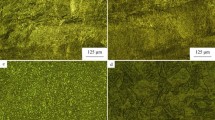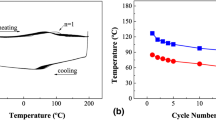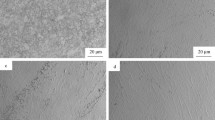Abstract
In this article, the effect of aging on martensitic transformation of Ti48.8Ni50.8V0.4 alloy was investigated. The results show that the martensitic transformation of the solution-treated shape memory alloy is a typical single-stage transformation process. The transformation temperatures of the samples aged at different temperatures for 0.5 h were lower as compared to that of the solution-treated alloy. With the increase of aging temperature, the transformation temperatures increase. After aging at 500 °C, the samples exhibit a multiple-stage transformation. The samples after aging at 500 °C for more than 5 h resulted in the transformation sequence of A → R→M1 and A → M2 upon cooling and M2 → A and M1 → A upon heating.
Similar content being viewed by others
Explore related subjects
Discover the latest articles, news and stories from top researchers in related subjects.Avoid common mistakes on your manuscript.
Introduction
Near-equiatomic TiNi shape memory alloys (SMAs) have attracted much attention because of their excellent shape memory effect (SME), superelasticity and damping capacity. The SME and superelasticity of TiNi alloys result from their thermoelastic martensitic transformation, which is either thermal- or stress-induced. The transformation temperature can be substantially affected by heat-treatment [1, 2], thermo-mechanical treatment [3, 4], thermo-mechanical cycling [5], and alloying [6, 7]. Among them, alloying is the most effective method to control the transformation temperature. The proper addition of vanadium (V) in the alloy can remarkably lower the transformation temperature that favors stable superelasticity at room temperature [8]. Previous reports on TiNiV alloy focused on the fundamental aspects, including precipitation behavior [9], martensitic transformation and SME [10]. When the V content is less than 2 at.%, the transformation temperature decreases with the increase of V content due to solid solution strengthening [10], and the shape recovery ratio defined as the ratio of shape recovery strain to deformed strain is slightly improved compared to the binary alloy. When the V content is in the range of 2–4 at.%, increasing the V content increases the transformation temperature [10].
Aging usually affects the transformation behavior of Ni-rich TiNi alloy by the precipitation of Ti3Ni4. Depending on the different aging treatments, Ni-rich TiNi alloys undergo a three-stage or even four-stage, transformation upon cooling [11, 12]. A comprehensive description of the linkage between aging process and martensitic transformation of a Ti49.1Ni50.9 alloy has been established [13]. Similarly, for Ti47.25Ni48.75V4 alloy, aging at 400 °C for 5 h causes the precipitation of the Ti3Ni4 phase, resulting in a two-stage martensitic transformation (parent phase with a b.c.c. structure (A) → R phase with a rhombohedral structure (R) → martensite with a B19′ monoclinic structure (M)) upon cooling, and a single-stage reverse transformation (M → A) upon heating [9]. However, further detailed concerning on the effect of aging on the martensitic transformation of TiNiV alloy is yet not available. In this study, the structure and martensitic transformation of a Ti48.8Ni50.8V0.4 alloy were investigated with an emphasis on the effect of aging on the transformation behavior.
Experimental procedures
A commercial Ti48.8Ni50.8V0.4 (at.%) in rod form was used. The samples were sealed in vacuum quartz tubes and then solution-treated at 900 °C for 2 h followed by quenching into water. The solution-treated samples were then aged in vacuum for 0.5 h at various temperatures between 300 and 600 °C and for various time intervals up to 10 h. After the aging treatment, the samples were slightly mechanically polished to remove the surface oxide layer. The X-ray diffraction (XRD) was carried out on a PANalytical Xpert’pro diffractometer using Cu Kα radiation at room temperature. The transformation behavior was characterized using a Perkin-Elmer Diamond differential scanning calorimeter (DSC) with a heating and cooling rate of 20 °C/min.
Results and discussion
Figure 1 shows the XRD patterns of the Ti48.8Ni50.8V0.4 after heat treatment. The solution-treated sample consisted of the B2 parent phase and minor (Ti,V)2Ni (Fig. 1a), indicating that the transformation temperature is below room temperature. The V9(Ti,Ni) phase reported by Lin et al. [9] in the solution-treated Ti47.25Ni48.75V4 alloy was not identified. When aging from 300 to 500 °C for 0.5 h, the phase constitution is little changed (Fig. 1a), but at 600 °C, new peaks appeared and are indicated by arrows which require identification. Figure 1b shows the XRD patterns of samples aged at 500 °C for different durations. All contain a mixture of the parent and (Ti,V)2Ni phases.
Figure 2a shows the DSC curve of the solution-treated sample with the transformation behavior characterized by a single-stage feature. The martensitic transformation start temperature (M s) was −23 °C and finish temperature (M f) at −35 °C with the peak temperature (M p)at −28 °C. The reverse transformation start temperature (A s) was −9 °C, the finish temperature (A f) −1 °C and the peak temperature (A p) −4 °C. The transformation temperatures were all below room temperature, consistent with XRD results (Fig. 1a). Figure 2b plots the DSC curves of the samples aged at different temperatures for 0.5 h. All underwent a single-stage transformation except for the alloy aged at 500 °C, where a weak peak appeared on the high-temperature side of the heating curve. Figure 2c shows the transformation peak temperatures (M p and A p) increase with increasing aging temperature, but are lower than the solution-treated alloy. This observation differs from TiNi binary alloys [8, 13].
Several factors can be related to the martensitic transformation behavior of the aged samples, including change of the matrix composition and stress field around the precipitates. Figure 1 shows that (Ti,V)2Ni phase formed in the solution-treated and the aged samples, which is consistent with the previous results on the Ti47.25Ni48.75V4 alloy [9]. The formation of (Ti,V)2Ni phase leads to the decrease of V content and the increase of Ni content in matrix. However, the change of V and Ni contents may weaken each other since the increases of V or Ni both reduces the transformation temperatures [8]. Therefore, it is suggested that the change of composition resulting from the (Ti,V)2Ni phase may take a minor role in determining the effect of aging temperature.
Aging in Ni-rich TiNi-based alloys usually results in the precipitation of Ti3Ni4 phase [8]. Lin et al. [9] reported that the Ti3Ni4 phase formed in Ti47.25Ni48.75V4 alloy during aging at 400 °C. In this study, it is suggested that the precipitation of Ti3Ni4 phase also occurs during aging. The precipitation of Ti3Ni4 phase may affect the transformation behavior by changing the matrix composition and creating the stress field. It is generally accepted that this precipitation leads to the increase of transformation temperature due to the depletion of Ni in matrix. However, this contradicts the present results shown in Fig. 2, indicating that the compositional changes due to the Ti3Ni4 phase is not a major influencing factor. The coherent stress field can act as effective obstacles against the martensitic transformation, leading to the reduction of transformation temperature [14]. With the increasing of aging temperature, the distribution density of Ti3Ni4 phase decreases since the formation of Ti3Ni4 phase necessitates less energy than the combination of such precipitates [15]. Therefore, it is suggested that the decreased density of Ti3Ni4 phase is mainly responsible for the increase of transformation temperature with the increasing of aging temperature. The recent results show that the sample aged at lower temperatures for 30 min has a higher critical stress to induce martensite (Tong, Liang, Unpublished data), which supports the above hypothesis.
The DSC curves of the alloys aged at 500 °C for different durations show that for aging no longer than 2 h, two transformation peaks appeared upon cooling (Fig. 3). The weak peaks on the high-temperature side of the curves are indicated by the arrows. The reverse transformation occurred in a two-stage manner upon heating as well. When aged for 5 h, the sample underwent a three-stage forward martensitic transformation upon cooling and a two-stage reverse transformation upon heating; with an aging duration of 10 h, this sequence did not change. Another notable characteristic is that as the aging duration increased, the transformation peak 3 on cooling and peak 1′ on heating became weak while their positions remained constant. For other peaks, not only the intensity varied with aging time, but also the peaks shifted toward the high-temperature side.
In order to identify the transformation peaks the samples aged at 500 °C for 10 h, the partial DSC cycle technique [16] was used. This method requires heating to 40 °C, and holding for 2 min to obtain the parent phase state; cooling to a predefined temperature and holding for 2 min before heating. The full cycle is shown as Fig. 4a. First, the end temperature of cooling was set between peak 1 and peak 2 (Fig. 4b). Besides the peak 2′ previously observed in the full cycle, a weak peak denoted by 1′′ was observed. The hysteresis between 1 and 1′′ is about 1.6 °C, thus this pair result from the reversible R-phase transformation, which is characterized by a small hysteresis due to its significantly small lattice deformation [17]. When cooled to a temperature between peaks 2 and 3, the sample showed only peak 2′ during heating (Fig. 4c), suggesting that peak 2 and 2′ are the forward and reverse process of same transformation, respectively, while peak 3 corresponds to peak 1′.
The three-stage transformation in TiNiV alloy has not previously been reported. Fan et al. [11] reported three-stage transformation behavior in Ni-rich TiNi alloys, and suggested that it resulted from the inhomogeneous distribution of Ti3Ni4 along grain boundaries with little encapsulated in the grain interior. Consequently, it may suggest that during cooling, the peak 1 in DSC curve corresponds to the A → R transformation in grain boundary region where the density of precipitate is high, the peak 2 is due to the R → M1 transformation in grain boundary region, and peak 3 is related to the A → M2 transformation of remaining parent phase in the grain interior. This suggestion is consistent with the observation that that the transformation temperatures of peak 3 and peak 1′ are not changed by aging.
When aged at 500 °C for 10 h and then cooled to the temperature defined in Fig. 4b, it is envisaged that the sample consisted of parent phase, R phase and martensite M1, since the peaks 1 and 2 partially overlap. Upon subsequent heating, the R phase reverse transformation occurred, resulting in the peak 1′′, while the peak 2′ was related to the reverse martensitic transformation (M1 → A). In order to confirm this, the end temperature was set higher (Fig. 4d). As compared with the results shown in Fig. 4b, the enthalpy of peak 1′′ which can be estimated from the area below the peak became larger, while that of peak 2′ (marked with a blank arrow, with enlarged image shown in the inset of Fig. 4d) became smaller. This implies the volume fraction taking part in the transformation of peak 1′′ increases, and at the same time, that related with peak 2′ decreases. When the alloy consists of parent phase and martensite M1, the latter directly transforms into the parent phase upon heating (Fig. 4c).
Another feature of Fig. 4b is that the enthalpy of the forward transformation upon cooling is obviously less than that of reverse transformation upon heating, possibly due to “thermal inertia” during cooling [18]. When held at the end temperature upon cooling, it is likely that some of the sample continues to transform into M1. This was confirmed by skipping the holding step in DSC method (Fig. 4b) was skipped by directly heating when the end temperature was reached(Fig. 4e). The trend of the DSC curve is quite similar to that observed in Fig. 4d, and consistent with the “thermal inertia” leading to the differences between the forward and reverse transformation enthalpy.
Conclusions
-
(1)
The solution-treated Ti48.8Ni50.8V0.4 alloy undergoes a single-stage martensitic transformation. After ageing for 0.5 h, the transformation temperature increases with the aging temperature from 300 to 600 °C, but is lower than that of the solution-treated sample. This possibly relates to the stress field resulting from the Ti3Ni4 precipitates.
-
(2)
When the samples were aged at 500 °C for no longer than 2 h, both the forward and reverse DSC curves are characterized by two-stage transformation. When aged at 500 °C for more than 5 h, the samples exhibit a transformation sequence of A → R→M1 and A → M2 on cooling and M2 → A and M1 → A on heating.
References
Nishida M, Honma T (1984) Scripta Metall 18:1299
Wu SK, Lin HC, Chou TS (1990) Acta Metall Mater 38:95
Hornbogen E (2004) J Mater Sci 39:385. doi:10.1023/B:JMSC.0000011492.88523.d3
Favier D, Liu Y, Manach PY (1995) J Phys IV 5:391
Miyazaki S, Igo Y, Otsuka K (1986) Acta Metall 34:2045
Eckelmeyer KH (1976) Scripta Metall 10:667
Mehrdad Z, Liu Y (2008) Adv Funct Mater 18:2789
Otsuka K, Ren X (2005) Prog Mater Sci 50:511
Lin HC, Yang CH, Lin MC, Lin CS, Lin KM, Chang LS (2008) J Alloys Compd 449:119
Lin HC, Lin KM, Chang SK, Lin CS (1999) J Alloys Compd 284:213
Fan GL, Chen W, Yang S, Zhu JH, Ren X, Otsuka K (2004) Acta Mater 52:4351
Su PC, Wu SK (2004) Acta Mater 52:1117
Zheng YF, Jiang F, Li L, Yang H, Liu Y (2008) Acta Mater 56:736
Rösner H, Schloßmacher P, Shelyakov AV, Glezer AM (2001) Acta Mater 49:1541
Kim JI, Miyazaki S S (2005) Acta Mater 53:4545
Favier D, Liu Y, McCormick PG (1993) Scripta Metall Mater 28:669
Miyazaki S, Wayman CM (1988) Acta Metall 36:181
Chen F, Tong YX, Tian B, Zheng YF, Liu Y (2010) Intermetallics 18:188
Acknowledgement
This study was supported by National Natural Science Foundation of China (51001035), the Fundamental Research Funds for the Central Universities (HEUCF101013) and the CityU research project (SRG #70012215).
Author information
Authors and Affiliations
Corresponding author
Rights and permissions
About this article
Cite this article
Tong, Y.X., Liang, C.Q., Chen, F. et al. Effect of aging on martensitic transformation behavior of Ti48.8Ni50.8V0.4 alloy. J Mater Sci 46, 6432–6436 (2011). https://doi.org/10.1007/s10853-011-5593-6
Received:
Accepted:
Published:
Issue Date:
DOI: https://doi.org/10.1007/s10853-011-5593-6








